
Rhythms in which long notes alternate with one or more short notes, so called because the long notes are usually written with the aid of the dot of addition (see Note values). Dotted rhythms are found in mensurally notated music of all periods; this article, however, deals mainly with music of the 17th and 18th centuries, in which it was customary to alter certain sorts of written rhythmic values in performance (see also Notes inégales; for notational meanings of the dot before 1600 see Notation, §III). The principal issue is the degree to which such rhythms sounded uneven, rather than the specific manner of their notation (e.g. the dot may be replaced by a rest or tie).
Dozens of contemporary theoretical and pedagogical sources indicate that the dot was ordinarily equal to one half the value of the note or rest preceding it, just as it is today. But the treatises also present various exceptions. The dot could stand for a tie (ex.1); dotted notes bearing ornaments, such as pre-cadential trills, were often held beyond their literal value to allow for fuller execution of the embellishments (see, for example, ex.12 below); and the dot could also represent a triplet (ex.2; the notation at (b) was very rare before the 19th century, see below). According to both Loulié (1696, MS additions) and Métoyen, the length of the dot is regulated in proportion to the notes that follow it: the greater their value, the less the dot is sustained, and vice versa. This view may account for some of the curious extra beaming found in works by Gigault and François Couperin (see, for example, ex.11 below). Both Nivers’ Livre d’orgue (1667) and Loulié’s revisions of his treatise employ the dot without a complementary shortening of the succeeding note (ex.3) to suggest the relatively mild unevenness of notes inégales, which was ordinarily unnotated; such ‘half-dotted’ notation was rare, however. But Gigault’s Livre de musique pour l’orgue (1685) is full of ordinary (3:1) dotted rhythms that apparently indicate notes inégales, and it is possible that composers outside France (e.g. Purcell) also dotted passages of diminutions to indicate French-style inequality. Written dotting at the customary rhythmic level of inequality (usually the quaver) intermixed with straight notes is legion in French music, and as late as 1782 Pierre Marcou reported that there was not ‘perfect agreement’ concerning the distinction between notated rhythms and the unwritten custom of notes inégales. In such cases one can only appeal to taste and common sense in determining whether the dotted notes are to be contrasted with a milder degree of unwritten inequality. (See Hefling, 1993, pp.5, 32–5, 52–5 and 66–8 for further details.)


![]()
Of greater import is the lengthening of the dot occasioned by the French custom of notes inégales. Common sense would suggest that in a situation like ex.4, in which French performers would customarily apply long–short (L–S) inequality to the quavers, the note after the dotted crotchet in the upper voice should coincide with the shortened sixth quaver in the lower part. Four 18th-century theorists specify such elongation of dots and shortening of the following little note(s) in the context of notes inégales (Hotteterre, Morel de Lescer, Métoyen and Engramelle), and three of them advocate the practice for unaccompanied performance (i.e. independently of the need to synchronize separate voices in polyphony). Engramelle also extends the principle to the shortening of a quaver anacrusis that begins a phrase (see Hefling, 1993, pp.68–70 and 145–50). The length of such overdotting is proportional to the degree of inequality, which, although probably mild in most cases (a ratio of 2:1 or less), could theoretically range from scarcely perceptible to the 3:1 ratio of a notated dot, depending upon the character of the piece. The stronger the inequality, the longer the overdotting. (Morel de Lescer actually describes double dotting.)

Overdotting concomitant with notes inégales would have affected a wide range of French pieces, including the minuet, sarabande, loure, marche, entrée, and the introduction to the French overture. This practice probably constitutes the background for Quantz’s famous instructions (1752) for the elongated execution of dotted rhythms in French overtures and dance music (even though he does not explicitly acknowledge a connection between overdotting and French inequality; see Hefling, 1993, pp.83–98, and in Historical Performance, 90–93). Quantz also advocates the contraction of upbeat tirades after a dot or rest in overtures, entrées, and furies, although only one earlier French source hinting at this has been located (Montéclair, c1735; ex.5, and also Hefling in Historical Performance, 88–9). J.S. Bach’s revision of the French overture in the second part of the Clavier-übung (BWV 831a/831) seems much akin to Quantz’s directives concerning the overture, and they are also echoed in the later writings of Kirnberger and Schulz, Türk, and Rellstab. (Only Kirnberger and Schulz, however, also mention French dance music, which was by then falling out of fashion.) Thus it would appear that French overdotting was a reasonably widespread performance mannerism.

Nevertheless, 20th-century claims of a universal ‘French overture’ or ‘splendid’ style have been considerably overstated (e.g. Dolmetsch, Dart and Donington), and there are no simple rules of thumb. In determining whether or not to introduce French overdotting (or any other rhythmic alterations) in a given work, today’s performer must carefully consider (1) whether the composer in question may have been familiar with the custom; (2) whether the composer’s manner of notation countermands such rhythmic alteration; (3) whether overdotted performance would have been practicable under the typical conditions of the period, in which full scores were relatively rare, performance parts were virtually never marked up during rehearsals (as is customary today), rehearsal time was generally scant, and the ensemble was typically controlled not by a conductor with a baton, but rather by a leader (usually the first violinist or harpsichordist) who also played with the group; (4) the expressive and stylistic impact of the altered rhythms.
Quantz was also the first writer to advocate general overdotting of relatively small note values, beginning at the level of the dotted quaver and semiquaver, and including the so-called Lombard snap (ex.6): this may be termed ‘galant’ overdotting. Between 1753 and 1790 several later writers (chiefly north Germans) advocate this practice to varying degrees (e.g. C.P.E. Bach, Leopold Mozart, J.F. Agricola and Türk); it cannot, however, be derived from notes inégales, nor does any writer associate it with French music. According to the treatises, the affective range of galant overdotting extends from the pleasing or ‘flattering’ to liveliness and boldness, depending upon style and tempo of the music in which it is adopted; it poses few difficulties in performance.
![]()
As noted above, the dot was used as a makeshift notation for 2:1 ratios in triplet contexts. C.P.E. Bach (1753) indicates that in such situations the third triplet and the semiquaver should be synchronized, and many scores cannot sensibly be interpreted otherwise. Nevertheless, C.P.E. Bach’s Berlin colleague Quantz insists that ‘you must not strike the short note after the dot with the third note of the triplet, but after it’ (1752, chap. V, §22), and J.F. Agricola claims this was also J.S. Bach’s teaching (Bach-Dokumente, iii, Kassel, 1972, p.206). A piece such as ex.7 can be effectively rendered either way (although in either case it is likely that the left-hand quavers would be assimilated to the right-hand triplets). (See Neumann, 1987, for further information and discussion.) The ambiguity of dotted notation in triplet contexts persisted well into the 19th century.
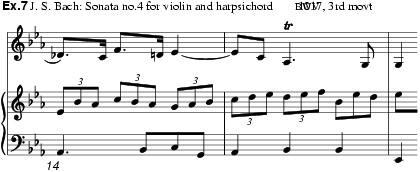
A fairly common notational shorthand in Baroque music is the failure to shorten the initial note of a dotted passage beginning with an upbeat (ex.8); according to Quantz, such upbeats should be shortened to fit with the prevalent dotted rhythms. Gigault, C.P.E. Bach, and Türk offer brief hints about the synchronization of larger and smaller dotted rhythms (ex.9), and as noted above, assimilation to the prevailing value is inherent in the French practice of overdotting concomitant with notes inégales. Synchronization is probably the appropriate solution, for example, in the opening sections of Handel’s French overtures, wherein apparently meaningless inconsistencies of rhythmic notation abound, very likely owing to haste. But in carefully written music one must ascertain whether the rhythm as notated is intended (as it probably is, for example, in variation 26 of Bach’s Goldberg Variations, ex.10).

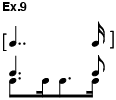
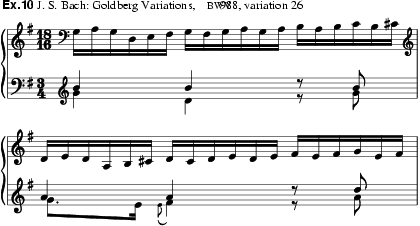
Other peculiarities in dotted notation include François Couperin’s multiplying the beams of short notes following a dot, perhaps to suggest very rapid execution (ex.11a–b). C.P.E. Bach advocated two new uses for the dot that were not taken up: adding a second dot with a stroke over it to indicate a silence of articulation in the elongated execution of a turn figure (ex.12), and dotting the figures of a continuo part to show the rhythm of the realization (ex.13). Some composers place the dot where it occurs rhythmically instead of directly after the note it prolongs (ex.14). This often puts it across the bar-line, where it obviates the need for a tie.
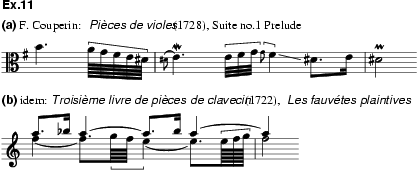

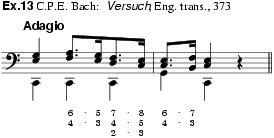

Double dotting occurs in French sources of the 17th and 18th centuries, most frequently in the keyboard works of Louis Couperin, Chambonnières and André Raison (not, however, in the viol music of Marin Marais, where the tremblement sign and dots used to indicate fingering can be misinterpreted as double dotting). Yet there is no apparent correlation between notated double dots and the French performance custom of overdotting concomitant with notes inégales (see Hefling, 1993, pp.70–78). Leopold Mozart’s influential violin treatise (1756 and later editions) recommends the double dot for the sake of clarity, and until the generation of his son Wolfgang notated double dotting remained relatively rare.
É. Loulié: Elements ou principes de musique (Paris, 1696, 2/1698; Eng. trans., incl. MS additions from F-Pn, f. fr. n. a. 6355, 1965/R)
M.P. de Montéclair: Petite méthode pour apprendre la musique (Paris, c1735)
J. Hotteterre: Méthode pour la musette (Paris, 1737/R)
J.-B. Métoyen: Démonstration des principes de musique (Paris, n.d.)
J.J. Quantz: Versuch einer Anweisung die Flöte traversiere zu spielen (Berlin, 1752/R, 3/1789/R; Eng. trans., 1966/R, 2/1985)
C.P.E. Bach: Versuch über die wahre Art das Clavier zu spielen (Berlin, 1753–62/R, 2/1787; Eng. trans., 1949)
L. Mozart: Versuch einer gründlichen Violinschule (Augsburg, 1756/R; Eng. trans., 1939, 2/1951/R)
J.F. Agricola: Anleitung zur Singkunst (Berlin, 1757; Eng. trans., 1995)
Morel de Lescer: Sçience de la musique vocale (Paris, c1760)
J.P. Kirnberger and J.A.P. Schultz: ‘Loure’, ‘Ouvertüre’, ‘Punkt: punktierte Note’, in J.G. Sulzer: Allgemeine Theorie der schönen Künste (Leipzig, 1771–4, 4/1792–9/R)
M.D.J. Engramelle: La tonotechnie au l’art de noter des cylindres (Paris, 1775/R)
P. Marcou: Elemens théoriques et pratiques de musique (London and Paris, 1782)
D.G. Türk: Klavierschule(Leipzig and Halle, 1789; Eng. trans., 1982)
J.C.F. Rellstab: Anleitung für Clavierspieler (Berlin, 1790)
A. Dolmetsch: The Interpretation of the Music of the XVII and XVIII Centuries (London, 1915/R, 2/1946/R)
T. Dart: The Interpretation of Music (London, 1954, 4/1967)
R. Donington: The Interpretation of Early Music (London, 1963/R)
D. Fuller: ‘Dotting, the “French Style”, and Frederick Neumann’s Counter-reformation’, EMc, v (1977), 517–43
F. Neumann: ‘La note pointée et la soi-distant “manière française”’, RdM, li (1965), 66–91; Eng. trans. in EMc, v (1977), 310–24
F. Neumann: ‘Facts and Fiction about Overdotting’, MQ, lxiii (1977), 155–85
D. Fuller: ‘The “Dotted Style” in Bach, Handel, and Scarlatti’, Bach, Handel, Scarlatti: Tercentenary Essays, ed. P. Williams (Cambridge, 1985), 99–117
F. Neumann: ‘Conflicting Binary and Ternary Rhythms: From the Theory of Mensural Notation to the Music of J.S. Bach’, Music Forum, vi (1987), 93–127
S.E. Hefling: Rhythmic Alteration in Seventeenth- and Eighteenth-Century Music: Notes inégales and Overdotting (New York, 1993)
D. Montgomery: ‘Triplet Assimilation in the Music of Schubert: Challenging the Ideal’,Historical Performance, vi (1993), 79–97
M. Bilson: ‘Triplet Assimilation in the Music of Schubert: a Reply’, Historical Performance, vii (1994), 27–31
D. Fuller: ‘Last Words on Inequality and Overdotting: a Review of Stephen Hefling's Book’, Performance Practice Review, vii (1994), 120–32
S.E. Hefling: ‘Déjà vu all over again? Rhythmic Alteration vs Neumann's Musical Protectionism’, Historical Performance, vii (1994), 85–94
S.E. Hefling: ‘Some Thoughts about ‘Last Words on Overdotting’’, Performance Practice Review, vii (1994), 133–45
STEPHEN E. HEFLING